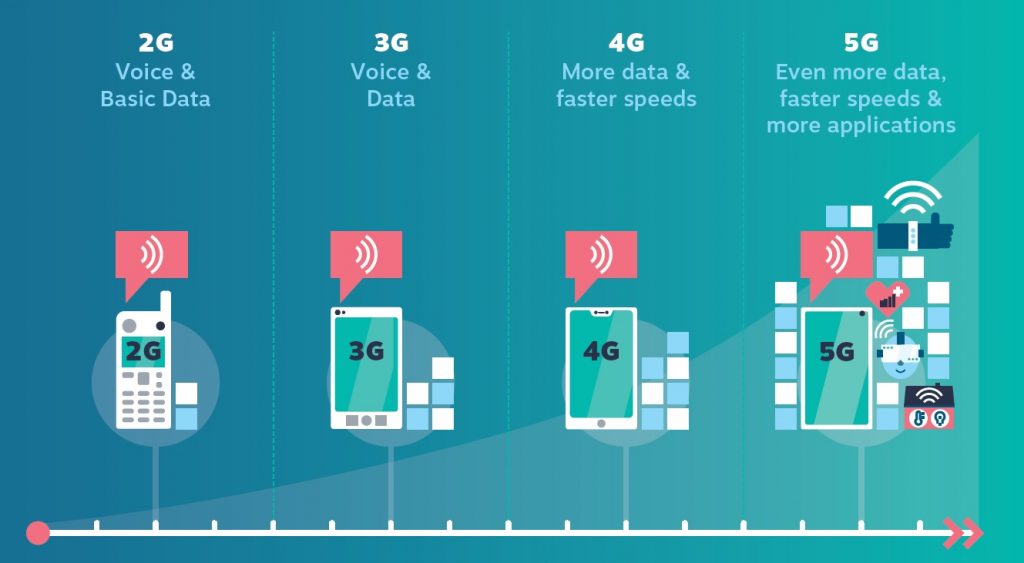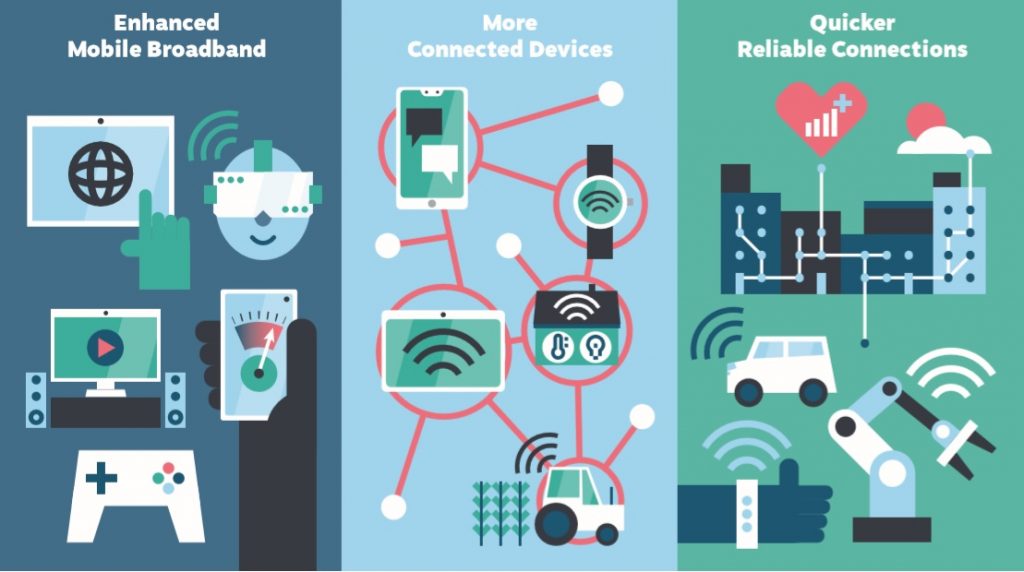About 5G
The evolution of mobile technology
Mobile technologies and services have evolved steadily over the past three decades and continue to do so. Ireland’s first “2G” mobile network was launched in 1993. In those early days users were limited to voice calls though within a few years they could also send and receive text messages. The early 2000s saw the first 3G networks and with them the first mobile internet services. These were followed by 4G networks in the early 2010s which offered faster mobile internet services.

2G
Voice & Basic Data
3G
Voice & Data
4G
More data & faster speeds
3G
Even more data, faster speeds & more applications
What is 5G?
5G is the next generation of mobile technology.
The coming decade should see the rollout of 5G networks across Europe and indeed most of the world. 5G will operate alongside other technologies to provide still faster data speeds and better connectivity. 5G is also a technology which would enable connectivity between wireless devices. This should support the expected massive growth in the number of wireless devices such as in machine-to-machine (M2M) communications and the Internet of Things (IoT), although other technologies may also be suitable depending on its application. These advancements should improve existing consumer services and lead to innovative new services like smart healthcare and connected vehicles.

- Enhanced Mobile Broadband
- More Connected Devices
- Quicker Reliable Connections
Mobile technologies and radio frequencies have become increasingly standardised throughout the world. This is why we can travel from Ireland to almost anywhere and still use our Irish mobile phones – locations change but the equipment and radio frequencies used to provide mobile services stay much the same.
The European Commission has published Frequently Asked Questions (FAQ) on 5G on its website available at ec.europa.eu
What are technology and service neutral licences?
Where possible, radio spectrum is awarded on a technology and service neutral basis, this being a principle of European law. This means that licensees may use the radio spectrum as they see fit provided that they comply with applicable harmonised standards. This gives operators freedom to continue to provide services on existing technologies (e.g. 2G, 3G, 4G) and flexibility to provide new services on new technologies (e.g. 5G), when ready to do so.
What is ComReg’s role in 5G?
Radio frequencies are a national resource managed by ComReg in accordance with EU law. Certain radio frequency bands are especially suited to mobile networks. There is generally high demand for those bands which is why they are normally granted on foot of competitive award processes, including auctions.
In Europe, three “Pioneer bands” radio frequency bands are marked for future 5G networks – 700 MHz, 3.6 GHz and 26 GHz.
ComReg granted new 3.6 GHz licences to five operators in June 2017 following a spectrum auction. ComReg is also currently consulting on a multi-band spectrum award, to include new licences in the 700 MHz band, and proposes to release new licences in the 26 GHz band through a separate future award. For more information please see the following ComReg webpages: 3.6 GHz band spectrum award; 3.6 GHz band transition; proposed multi-band spectrum award; and Ireland’s national roadmap on the use of the 700 MHz frequency band.
In managing the national radio frequency resource ComReg also monitors compliance with conditions attached to licences and to the general authorisation, including in relation to non-ionising radiation (NIR).
In addition, ComReg facilitates the testing and trialling of new technologies and services with the use of ComReg’s Test and Trial Licensing programme.
Roles of other public bodies in relation to 5G and Non-Ionising Radiation
ComReg does not have any role in relation to the health effects of Non-Ionising Radiation (NIR), occupational exposure to NIR, or planning matters, and does not make decisions in relation to the location or installation of telecommunications masts. These matters are dealt with by other public bodies.
Department of Environment, Climate and Communications (DECC)
DECC is responsible for setting policy relating to the health effects of Non-Ionising Radiation (NIR) including electromagnetic fields. For more information please see https://www.gov.ie/decc.
Environmental Protection Agency (EPA)
The functions of the Environmental Protection Agency (EPA) include the provision of independent expert advice to the Government and to the public on exposure to NIR (including on relevant standards for public protection), as well as the monitoring of scientific/technological developments likely to impact on public exposure to NIR. For more information please see the EPA website at http://www.epa.ie/radiation/emf and the EPA’s brochure on “5G and Health
Local Authorities
The siting of telecommunications masts and equipment is a planning matter in respect of which ComReg has no statutory function or role. Planning at local level is the responsibility of local authorities. Please contact your local council if you seek information on the planning status of a mast or other telecommunications equipment in your area (e.g. if planning permission was required and, if so, who sought that permission). For more information please see http://www.housing.gov.ie/planning/.
Health and Safety Authority (HSA)
The HSA regulates exposure to NIR in the workplace in accordance with EU Directive 2013/35/EU. For more information please see https://www.hsa.ie/
